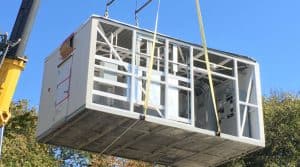Amy Marks joined Autodesk in late 2019 as the ‘Head of Industrialised Construction Strategy and Evangelism’. Previous to this, Amy was CEO of XSite Modular where she defined the language and processes that are now adopted by companies, countries, and builders globally to enable and optimise prefabrication as a subset of Industrialised Construction. Amy speaks with Irish building magazine about her experience and what Industrialised Construction offers.
Amy Marks grew up in New York construction. Her father was a contractor. From an early age she knew the advantages of prefabrication. She rose in the industry to become CEO of XSite Modular, an international designer and builder of critical infrastructure buildings; structural steel and concrete buildings, built to withstand harsh environments, such as destructive storms and seismic loads.
As CEO of XSite, 10 years ago she went deeper into offsite systems research and became known as an offsite expert, offering the first prefabrication integration international consulting services. Now in her new role at Autodesk, with the great resources of the software giant, she is influencing global design and construction towards a more industrialised future.
Amy’s role is Head of Industrialised Construction Strategy of which prefabrication is a part. Leveraging Autodesk’s consulting arm, she advises clients on industry strategy and works with individual companies to help them get on the path of Industrialised Construction.
Work

Aside from prefabrication, as part of ‘Industrialised Construction’ Amy has expertise in automation, robotics and additive manufacturing. She thinks the British term ‘Modern Methods of Construction’ is a great umbrella term for these methods but Autodesk uses ‘Industrialised Construction’ as a term for including digitisation, Lean Construction, and lifecycle thinking. Amy works in Australia and Singapore and she says there is often confusion regarding the terminology around prefabrication. Interestingly, many people in American prefabrication are going to Singapore as they can expand there with the demand for their products. With terminology and the introduction of new technologies to construction, she believes it is difficult to find a term that encompasses all methods and innovations. “My old company was titled ‘XSite’ as it was an offsite company. However, looking at companies like Mace who are prefabricating on site, you can’t call this ‘offsite construction’. It’s on-site prefabrication.”
Evolving
Ray O’Rourke is a hero of Amy’s and like him, she is evolving Design for Manufacture and Assembly (DfMA) with emphases on thinking in detail and end of use. “I’m teaching a class on ‘Design for Manufacture and Assembly, Disassembly and Reuse’. These general principles and terms are great for understanding a process but they don’t teach you to design a mechanical distribution rack as there are details involved. Whether it is a bathroom pod, elevator shaft or distribution rack, the principles will only help you so far. ‘Industrialised Construction’ encompasses what we can do better. ‘DfMA’ is limiting. I want to evolve the terminology and enable prefabrication through this design methodology.”
Anything you can build offsite and assemble on site will help you reduce your programme. For the industry to advance further, Amy says people need to think about prefabricating the more complex, once-off area of their building, not just the repeatable modular units. “This will be the evolution of offsite thinking.”
Amy believes we need DfMA and prefabrication for certainty. This is more critical than savings. “Traditional projects are based on estimates and often a project deemed a success is over budget and programme. Prefabrication and Industrialised Construction creates certainty around scope, cost and schedule, addressing the main client concerns. Once you have certainty and you have the right ecosystem, you can have savings. Autodesk has a lot to offer here.”
Adaption
Amy says the industry’s sectors are adapting differently to prefabricated methods and have different motivating factors. “Housing is obvious, given we have an international crisis and housing costs are a problem around the globe. The simplistic structures such as houses are suited to prefabrication. This is a sector that is benefiting from prefabrication, but so far it is very fragmented. Healthcare has also been an early adopter. Technology companies in the data centre sector have embraced prefabrication. Sectors like telecommunications, which understand the benefits, are great adapters. Different sectors have different drivers to adopt. For example in healthcare, you want to remove the dirty work and dust, and you want to deliver a clean building. In housing, you want a fast build.”
Asked about the work that impresses her, Amy says it would be easy to identify large projects undertaken by leading companies. But the real outstanding prefabrication work is undertaken by subcontractors that nobody hears about. “All those MEP contractors who invested in fabrication facilities have brought the industry forward. They are productive and driving prefabrication on jobs. We need to hear more about the manifold and rack prefabricators and plant room prefabrication companies. Subcontractors are leaders in prefabrication. Roles in construction are changing with technology. We can’t keep doing the same thing, the industry is changing.
Factory
Amy is a fan of Lean Manufacturing and Construction and believes in continuous learning and carrying learnings forward in a factory environment. There are great opportunities to teach and upskill people in a factory. “Factories are not project-centric. What’s learned in a factory can be transferred to other projects in real-time. You can’t do this on site where you start over new again. Specialists can work on specific skills being task-centric. It’s a more socially acceptable way to build instead of putting people on job sites.”
Amy’s support of manufacturing over on-site work is partially influenced by international experience, visiting many countries. “I’ve been around the world and watched grandmothers tying rebar in their bare feet; seen all kinds of unsafe site practices in developed and underdeveloped countries. We must be more socially responsible in construction.” Aside from the support that safer environments can provide, Amy says she has seen major inefficiencies on site that could have been figured out on the drawings. Amy also believes the facilities of factories would help us get new people into the industry. “We need to work in a new way that allows innovation and attracts young people.”
Amy was a principal in a factory that was 200,000 sq ft and she knows the difference environment can make on a workforce. Factory work can also change the nomadic nature of construction. “There are great benefits to working in a controlled environment. Aside, parents can have facilities like childcare nearby, and can be close to home. Integrating technologies into a building in a factory is also inviting to young people who might not be attracted to site work. I would say to governments, invest in factories. They will provide sustainable places to work; they will encourage more women to enter construction.”
XSite
XSite’s previous design-build side is now currently delivering medical modular units and Amy’s team are working on critical projects across America with modular healthcare fabricator Blox. This freed her up to work with Autodesk. “I want to make Industrialised Construction easier for people to adopt. Autodesk has all the puzzle pieces to make industrial construction easier: leadership, processes, resources, technology, and culture. I sit with COVID-19 construction task forces and they understand that digitising and using prefabrication is critical to the resiliency of companies and the industry. These companies are striving to make their companies better than before, providing an improved environment for staff.”
We are on the road to a more industrialised industry, but progress will bring challenges. At XSite, Amy overcame major challenges on projects. Before Amy departed for Autodesk, XSite built a telecommunications building in the Pacific Islands that was designed and built for a 100-year storm with 200mph winds. Six months later there was a ‘200-year storm’, the worst in the island’s history. The building was undamaged by the storm. “The island kept its critical internet services because of this building.” Getting to the professional level to deliver this infrastructure with certainty was a journey.
Journey
Contractors must start maturing in digitisation, collaboration software and BIM before entering Industrialised Construction. “Construction is on a journey. BIM is not the end. It’s the foundation and highway that allows cars to move faster. BIM combined with DfMA and prefabrication enables construction to be smarter, and to optimise manufacturing processes and automation. I like to evaluate a building programme with different lenses. I’m always looking to make things easier and outcomes more certain.”
Construction has been traditionally insular. But Amy says construction is not slow, or behind on purpose. “We are project-centric. Money is put in contingency instead of putting it in R&D or upfront. The projects’ cycle times are long and we are not often incentivised to be proactive in change.”
Amy says professionals have told people about innovation and automation in construction but have not shown them; identifying clearly what is used at present in manufacturing. “There are processes and machinery used in other industries that are established and we could use them in our industry, and they would be seen as new but they are not. We need to point out to construction executives that we can work with plant and processes and produce better work, and it will not be a major change.” Amy sees Autodesk as able to engage and empower the construction supply chain on the journey to Industrialised Construction. “We can help influence behaviours, improve processes and provide leadership. The ecosystem is there and is developing, construction will be industrialised.”
As we know from many Irish firms, prefabrication does not just benefit national infrastructure. You can export around the world. “I was a U.S. businesswoman shipping buildings to China. This is what Irish companies can do. Ireland has contractors that excelled in data centre construction. I can see Irish companies excelling, becoming a world leader.”
Challenges
Professionals are territorial about their work duties and titles. But construction is changing. Skilled tradespeople are getting rarer and we should be learning from these people and taking that knowledge forward. Amy says we can’t automate all skilled people’s tasks but we have to start trying to get down on paper or in digital what people who are near retirement or retired know. “We need to get these people to sit down with technicians to pass on their expertise to the next generation who will try to automate work. Trades will always exist but for scale, we need automation. I’m a builder and come from a tradition of developing skills but I also see the need for change.”
Having worked globally, Amy believes scale is not an excuse to not enter Industrialised Construction. She has worked in many small countries and in underdeveloped countries that have successfully adapted prefabrication. However, one of the leading countries in prefabrication is Singapore where the government has invested time and hundreds of millions to develop their strategy and capabilities. This is noteworthy.
SMEs can view developing offsite products as outside of their capabilities. However, Amy says size should be seen as positive. “Small businesses don’t have many barriers because they don’t have legacy infrastructure. This allows a company to leapfrog ahead. This is an advantage; they can pivot and get on the path with a little investment.” From a national perspective, like Ireland’s, Amy says being an island is a benefit. “Ireland has major advantages and the contractors are doing amazing work in Digital Construction, BIM and offsite. The Irish have passion for construction, skillsets and knowledge.”
Advice
Amy works with public policy at Autodesk to educate governments on what they can do to build an ecosystem for Industrialised Construction. Her advice to the Irish Government is to incentivise companies to digitise, using collaborative software and BIM, and develop expertise in industrial construction like prefabrication and automation. “The only way things get done is by learning and asking for information, and this happens when they require prefabrication. Having a Minister of Construction could be beneficial as a point of leadership.” From her role and travelling the world, Amy is aware of the work of Irish contractors and says Ireland has companies that can lead the world in Industrialised Construction. “Thinking of Ireland I think of great companies with impressive portfolios like BAM Ireland, Sisk, and Mercury.”
For companies starting out, she says a company must have a learning culture, digitised tools, good training and great future-looking leadership. “When I do a maturity analysis or a prefabrication readiness analysis, I look at these factors to assess if they are ready to move forward in Industrialised Construction.”
Amy plans to speak at the virtual Connect & Construct Summit and AU London in December, and once she’s able hopes to visit Dublin. She’s interested in meeting Irish companies. “Reach out to me. Attend Autodesk University, which will now be held online. I can put you in contact with experts that can make you a more productive company. If I can’t help you, I know people who can.”
The content of this site is subject to copyright laws and may not be reproduced in any form without the prior consent of the publishers. The views expressed in articles do not necessarily represent those of the publishers. This article first appeared in Irish building magazine.




